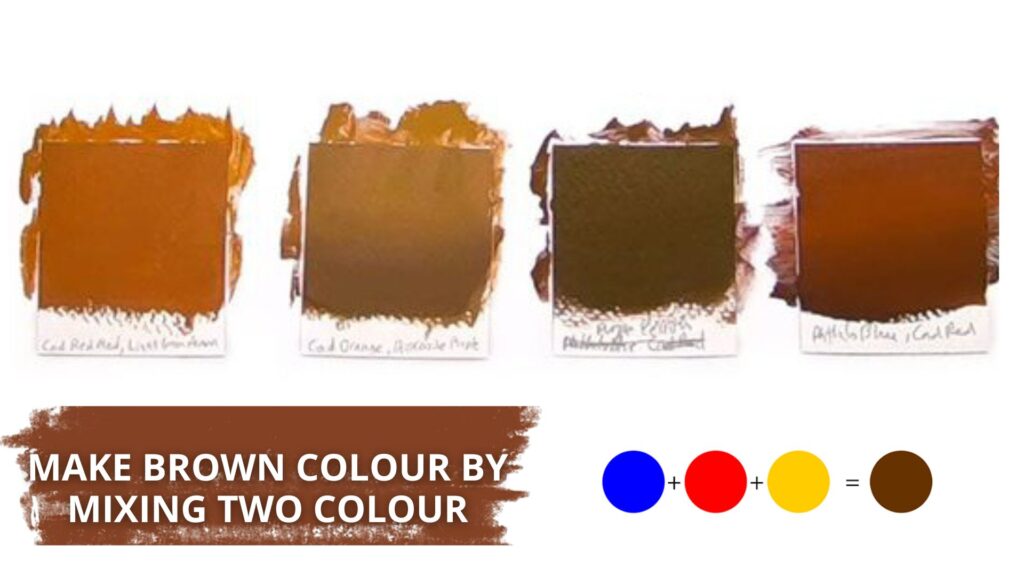
About Us
At our forefront, we redefine elegance and vibrancy in interior design. As prominent highlighter tile manufacturers, we specialize in crafting exquisite tiles that infuse spaces with captivating allure.
Latest Post
- Blog
- September 3, 2024
- highlightertiles.in
- 11:56 am
How to Make Brown Colour by Mixing Two Colour

Brown is one of the most important colors used in the field of art, design, and interior decoration. It exudes coziness, safety, and nature and is universally liked. However, what if you want to mix different colors to form the appropriate hue of brown but you only have two basic colors? Worry not! In this article, we shall start from the basic article and show you how to make brown color by mixing two colors, understanding the ideas of color theory, practical techniques on mixing, and several methods used to make different kinds of brown paints and to achieve new creations.
Understanding Color Theory
Before proceeding to the details about how one should create the color brown, it is important first to learn the principles of color mixing. The color wheel is one of the most important tools in this process. It has primary colors, secondary colors, and tertiary colors.
- Primary Colors: They are a red color, blue color and yellow color. Other colors can not be achieved by combining as they are considered to be basic.
- Secondary Colors: They are green color, orange color and purple color. These are achieved by using two primary colors.
- Tertiary Colors: These are brought about by mixing one of the primary colors with one of the secondary colors that include, for instance, red and orange, yellow and green.
Brown can be said to be known as a composite because it can be produced by mixing more than one color. The most effective way to prepare brown is to realize that it is a mixture of other’s complement; those colors that are sitting face to face in a color wheel.
1. Basic Color Mixing to Create Brown
Mixing Complementary Colors
This is the logical and perhaps easiest way of creating that particular color ‘brown’ – mixing two complementary colors. Complementary colors are pairs of colors that when added together, the effects of the colors are canceled, thus resulting in a neutral color, in this case brown. Some examples include;
- Red with Green: When a primary color red is added to a secondary color blue it results in a basic color brown. The same primary shade of brown can thus be made darker or lighter by varying the ratio of the two colors of green and red.
- Blue with Orange: Blue and orange in combination yield a much more subtle brown. Orange comes from the combination of red and yellow making this mixture a warm and cool mix.
- Yellow with Purple: Yellow and purple could also mean brow. To make purple yellow gives an adequate amount hence the absence of brown is impossible since purple is a secondary color built from red and blue.
2. Mixing Primary Colors
A different way of making brown is to combine the three primary ones.
- Red + Blue + Yellow: All three colors in balance will generally provide neutral brown. By compensating for these proportions, one can get lighter or darker brown shades. For instance, more red will give a warmer tone of brown while more blue will cause a cooler tone of brown.
Creating Different Shades of Brown
Brown is not just a unified vision, but different variations like beige or black. Such steps please the mod because brown is a complicated color that can be obtained in different ways.
Light Brown
When making this color you can start by taking the basic mixture and rather than using red pigment like in most techniques, use white as an additive. While using this factor, this particular brown formula will change to either tan or beige. Often you could try warm beige shades by putting a little bit more yellow into the brown base – such mixes will warm and illuminate the shade.
Dark Brown
T A Brown of this kind has red, orange or yellow as color undertones. Now for warm browns try blending your general brown pigment then add red or yellow pigment after. For a warm brown, for example, if green and red are combined, more red must be added. Blue and orange will also produce one warm yet subtle brown upon mixing it with orange.
Warm Brown
A Brown of this kind has red, orange or yellow as color undertones. Now for warm browns try blending your general brown pigment then add red or yellow pigment after. For a warm brown, for example, if green and red are combined, more red must be added. Blue and orange will also produce one warm yet subtle brown upon mixing it with orange.
Cool Brown
Cool browns may have a warming undertone of blue or purple as well. If you would like cool brown, combine your base colors then add more blue or purple this time. This is great for achieving mid-tone browns with a bit of an overcast or muted quality which works pretty well in shading or cooler designs.
3. Practical Tips for Mixing Brown
Experiment Gradually
It can be helpful to use small quantities when mixing colors. A little more of a darker shade can be added rather than trying to lighten a too-dark color. Mixing colors in small parts enables the artist to achieve the color they desire with ease.
Keep a Color Mixing Chart
A color mixing chart is very useful for artists as well as designers. You may later want to recreate a certain shade of brown and recording the colors and ratios used can always come in handy. This chart can be used for reference purposes especially when working with larger projects that require some level of uniformity.
Use a Palette Knife
In mixing colors, a palette knife is equally important as a brush as it can be used to swirl the colors even though it is more effective for blending all the colors. It leads to an even distribution of the colors and gets rid of chances of sticking that exist with the use of brushes.
Consider the Medium
Different mediums, acrylic, oil, watercolor etc., will affect the mixing of the colors. For instance watercolors being more transparent often require layering in order to get the right color. Oil paints have long drying times so that the mixing on the canvas can be altered for a longer time. It is wise to consider the attributes of your medium while mixing colors.
4. Applications of Brown in Art and Design
Brown is one such color which has amazing applicability in almost all art forms as well as design fields. The warm characteristics of this hue make it a good candidate for developing depth, contrast, and warmth in any composition.
In Painting
In art practice, the color brown is mostly applied for shadow-making, adding body to an artwork, and for anchoring. It is a dull color. We have for instance artists if the nature has to be depicted. They would use brown because it is used for things like trees, earth, and other materials.
In Interior Design
Brown is widely used by many people in the interior designers because it is meant to bring out warmth, warmth and stability of the environment. Brown shade has been dominating the wood varnish, leather usage in furniture and other clothes. There is also a movement away from tints towards pure colors. This helps when thinking about how to arrange an interior space.
In Fashion
Brown in fashion is a very classic and yet sophisticated shade which brings class to any outfit worn. In this order, various shades of brown can be ranged from dark chocolate to tans which are included in cloth, shoes, and accessories. There is no doubt that having knowledge on how to wear different shades of browns complementing their other clothes can be useful in any situation.
In Digital Design
For those who produce and paint on screens or perhaps for graphic designers as well as painters, it is a must to comprehend color blending. One useful feature of brown is that it can be used in digital drawings or designs for creation of realistic textures, backgrounds and other elements. Apart from that, this is the basic rule in every graphic designer’s implementation of color shifts.
5. Troubleshooting Common Issues
Muddy Colors
One common problem arising when combining brown is obtaining a muddied or dull final color. This often occurs when there is indiscriminate mixing of colors with no sense of direction. To solve the problem, limit the number of colors to two opposites or a controlled combination of primary colors. Moreover, in case the hue gets too muddy, a little bit of white can lift the color.
Uneven Mixing
When there are streaks in your brown color or in spots of your painting instead, a bases of clay colored paint, then this might be caused by poor stratification. Do not simply add more colors but instead use a palette knife or mix all the colors thoroughly with a brush for even distribution. In the case of working digitally, use tools which are capable of smooth blending to solve this problem.
Incorrect Shade
When the brown that you have mixed goes beyond your preparation, it is prudent to determine which tones are governing your blend. For instance, if your brown tends to be too warm, perhaps you have overwhelmed the mix with red or yellow. Apply a little touch of blue and see if that works. On the contrary, if it is the brown that is too cool, make warm with a little more of red or yellow.
Conclusion
It is quite common for an artist to use the characteristically ugly color brown as a mixture of at least two other colors. A knowledge of color mixing is essential for anyone who is in the field of art be it as an artist, a designer or a hobbyist so that one can make the desired brown color for every need. Try out using complementary colors as well as changing their ratios to make many shades of brown, those that may be warm and earthy or cool and sophisticated.
As the name suggests, brown is in the background and without it; any work will not look complete. Brown color is used for giving the effect of shadows and depth for objects and very often having the right training and diligence one can learn how to mix brown and get used in his works.